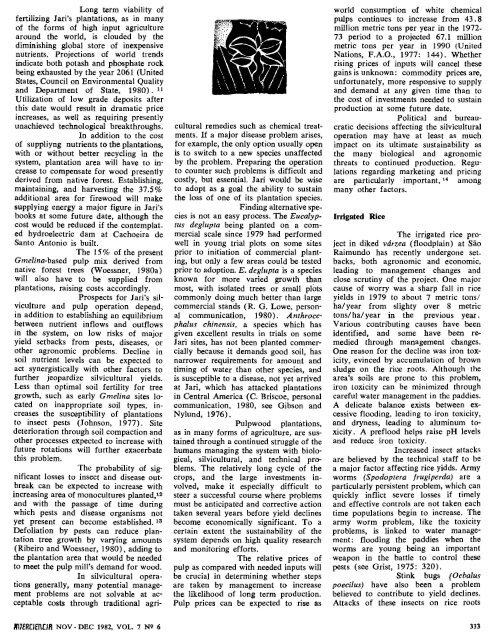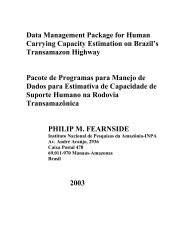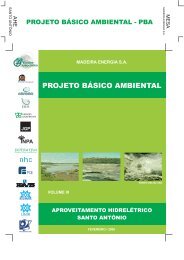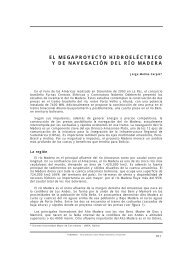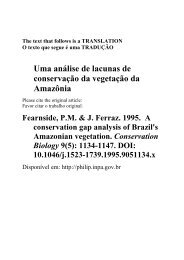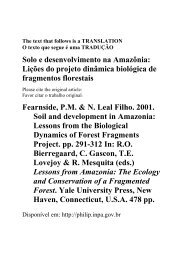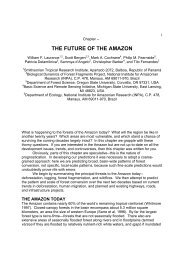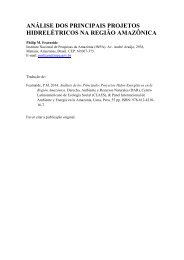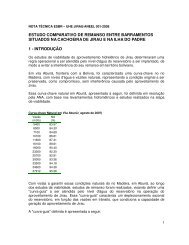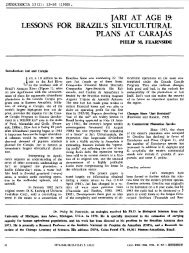the new jari - Philip M. Fearnside - Inpa
the new jari - Philip M. Fearnside - Inpa
the new jari - Philip M. Fearnside - Inpa
Create successful ePaper yourself
Turn your PDF publications into a flip-book with our unique Google optimized e-Paper software.
Long term viability offertilizing Jari's plantations, as in manyof <strong>the</strong> forms of high input agriculturearound <strong>the</strong> world, is clouded by <strong>the</strong>diminishing global store of inexpensivenutrients. Projections of world trendsindicate both potash and phosphate rockbeing exhausted by <strong>the</strong> year 2061 (UnitedStates, Council on Environmental Qualityand Department of State, 1980). 11Utilization of low grade deposits afterthis date would result in dramatic priceincreases, as well as requiring presentlyunachieved technological breakthroughs.In addition to <strong>the</strong> costof suppliyng nutrients to <strong>the</strong> plantations,with or without better recycling in <strong>the</strong>system, plantation area will have to in·crease to compensate for wood presentlyderived from native forest. Establishing,maintaining, and harvesting <strong>the</strong> 37.5%additional area for firewood will makesupplying energy a major figure in Jari'sbooks at some future date, although <strong>the</strong>cost would be reduced if <strong>the</strong> contemplatedhydroelectric dam at Cachoeira deSanto Antonio is built.The 15% of <strong>the</strong> presentGmelina-based pulp mix derived fromnative forest trees (Woessner, 1980a)will also have to be supplied fromplantations, raising costs accordingly.Prospects for Jari's silvicultureand pulp operation depend,in addition to establishing an equilibriumbetween nutrient inflows and outflowsin <strong>the</strong> system, on low risks of majoryield setbacks from pests, diseases, oro<strong>the</strong>r agronomic problems. Decline msoil nutrient levels can be expected toact synergistically with o<strong>the</strong>r factors tofur<strong>the</strong>r jeopardize silvicultural yields.Less than optimal soil fertility for treegrowth, such as early Gmelina sites locatedon inappropriate soil types, increases<strong>the</strong> susceptibility of plantationsto insect pests (Johnson, 1977). Sitedeterioration through soil compaction ando<strong>the</strong>r processes expected to increase withfuture rotations will fur<strong>the</strong>r exacerbatethis problem.The probability of significantlosses to insect and disease outbreakcan be expected to increase withincreasing area of monocultures planted,12and with <strong>the</strong> passage of time duringwhich pests and disease organisms notyet present can become established. 13Defoliation by pests can reduce plantationtree growth by varying amounts(Ribeiro and Woessner, 1980), adding to<strong>the</strong> plantation area that would be neededto meet <strong>the</strong> pulp mill's demand for wood.In silvicultural operationsgenerally, many potential managementproblems are not solvable at acceptablecosts through traditional agri-cultural remedies such as chemical treatments.If a major disease problem arises,for example, <strong>the</strong> only option usually openis to switch to a <strong>new</strong> species unaffectedby <strong>the</strong> problem. Preparing <strong>the</strong> operationto counter such problems is difficult andcostly, but essential. Jari would be wiseto adopt as a goal <strong>the</strong> ability to sustain<strong>the</strong> loss of one of its plantation species.Finding alternative speciesis not an easy process. The Eucalyptusdeglupta being planted on a commercialscale since 1979 had performedwell in young trial plots on some sitesprior to initiation of commercial planting,but only a few areas could be testedprior to adoption. E. deglupta is a speciesknown for more varied growth thanmost, with isolated trees or small plotscommonly doing much better than largecommercial stands (R. G. Lowe, personalcommunication, 1980). A nthrocephaluschinensis, a species which hasgiven excellent results in trials on someJ ari sites, has not been planted commerciallybecause it demands good soil, hasnarrower requirements for amount andtiming of water than o<strong>the</strong>r species, andis susceptible to a disease, not yet arrivedat Jari, which has attacked plantationsin Central America (C. Briscoe, personalcommunication, 1980, see Gibson andNylund, 1976).Pulpwood plantations,as in many forms of agriculture, are sustainedthrough a continued struggle of <strong>the</strong>humans managing <strong>the</strong> system with biological,silvicultural, and technical problems.The relatively long cycle of <strong>the</strong>crops, and <strong>the</strong> large investments involved,make it especially difficult tosteer a successful course where problemsmust be anticipated and corrective actiontaken several years before yield declinesbecome economically significant. To acertain extent <strong>the</strong> sustainability of <strong>the</strong>system depends on high quality researchand monitoring efforts.The relative prices ofpulp as compared with needed inputs willbe crucial in determining whe<strong>the</strong>r stepsare taken by management to increase<strong>the</strong> likelihood of long term production.Pulp prices can be expected to rise asworld consumption of white chemicalpulps continues to increase from 43 . 8million metric tons per year in <strong>the</strong> 1972-73 period to a projected 67.1 millionmetric tons per year in 1990 (UnitedNations, F.A.O., 1977: 144). Whe<strong>the</strong>rrising prices of inputs will cancel <strong>the</strong>segains is unknown: commodity prices are,unfortunately, more responsive to supplyand demand at any given time than to<strong>the</strong> cost of investments needed to sustainproduction at some future date.Political and bureaucraticdecisions affecting <strong>the</strong> silviculturaloperation may have at least as muchimpact on its ultimate sustainability as<strong>the</strong> many biological and agronomicthreats to continued production. Regu·lations regarding marketing and pricingare particularly important, 14 amongmany o<strong>the</strong>r factors.Irrigated RiceThe irrigated rice projectin diked varzea (floodplain) at SaoRaimundo has recently undergone set.backs, both agronomic and economic,leading to management changes andclose scrutiny of <strong>the</strong> project. One majorcause of worry was a sharp fall in riceyields in 1979 to about 7 metric tons/ha/ year from slighty over 8 metrictons/ ha/ year in <strong>the</strong> previous year.Various contributing causes have beenidentified, and some have been remediedthrough management changes.One reason for <strong>the</strong> decline was iron toxicity,evinced by accumulation of brownsludge on <strong>the</strong> rice roots. Although <strong>the</strong>area's soils are prone to this problem,iron toxicity can be minimized throughcareful water management in <strong>the</strong> paddies.A delicate balance exists between excessiveflooding, leading to iron toxicity,and dryness, leading to aluminum toxicity.A preflood helps raise pH levelsand reduce iron toxicity.Increased insect attacksare believed by <strong>the</strong> technical staff to bea major factor affecting rice yidds. Armyworms (Spodoptera frugiperda) are aparticularly persistent problem, which canquickly inflict severe losses if timelyand effective controls are not taken eachtime populations begin to increase. Thearmy worm problem, like <strong>the</strong> toxicityproblems, is linked to water manage·ment: flooding <strong>the</strong> paddies when <strong>the</strong>worms are young being an importantweapon in <strong>the</strong> battle to control <strong>the</strong>sepests (see Grist, 1975: 320).Stink bugs (Oebaluspoecilus) have also been a problembelieved to contribute to yield declines.Attacks of <strong>the</strong>se insects on rice rootsN\1ERCIEI\[IR NOV- DEC 1982, VOL. 7 N9 6333


